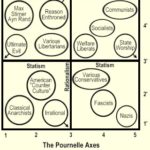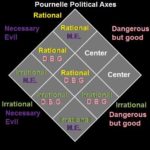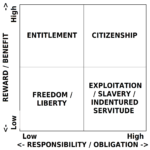The Pournelle Political Axis
 The Pournelle chart, developed by Jerry Pournelle in his 1963 political science Ph.D. dissertation, is a two-dimensional coordinate system which can be used to distinguish political ideologies. It is similar to the political compass and the Nolan Chart in that it is a two-dimensional chart, but the axes of the Pournelle chart are different from those of other systems. The two axes are as follows:
The Pournelle chart, developed by Jerry Pournelle in his 1963 political science Ph.D. dissertation, is a two-dimensional coordinate system which can be used to distinguish political ideologies. It is similar to the political compass and the Nolan Chart in that it is a two-dimensional chart, but the axes of the Pournelle chart are different from those of other systems. The two axes are as follows:
- The x-axis, “Attitude toward the State” (labeled statism), refers to a political philosophy‘s attitude toward the stateand centralized government. The farthest right is “state worship” and the farthest left represents the state as the “ultimate evil”, preferring individual freedom.
- The y-axis, “Attitude toward planned social progress” (labeled rationalism), refers to the extent which a political philosophy is compatible with the idea that social problemscan be solved by the use of reason. The top indicates complete confidence in planned social progress and the bottom represents skepticism of such methods, often considering them as naively utopian. Those at the top of the axis would tend to discard a traditional custom if they do not understand what purpose it serves (considering it antiquated and probably useless), while those at the bottom would tend to keep the custom (considering it time-tested and probably useful).
Pournelle arranged American liberalism, socialism, and communism, in the upper right-hand quadrant of high state control and high rationalism. Conservatism, fascism, and Nazism are placed in the lower right hand quadrant of high state control and low rationalism. Classical anarchists are in the lower left hand corner of low state control and low rationalism. Libertarians (including anarcho-capitalists) and Objectivists are placed in the upper left-hand corner of low state control and high rationalism. Each diagonal axis contains natural political allies.

Reviewed in the United States on August 13, 2001
JERRY POURNELLE IN THE OPENING OF IMPERIAL STARS
One reason my old editor and later publisher Jim Baen kept me around is that he liked to talk. We’d have endless telephone discussions of column topics, and they would tend to spill over to anything else going on. In the course of one conversation we got to the subject of the Ayatollah Kockamamie, and Jim said something about “all ends of the political spectrum …er, points.”
“Curious you should put it that way,” I replied. “I wrote my dissertation in political science on a proof that the political spectrum has more than one dimension; that the old left-right category doesn’t really work.”
“Now there’s a column,” Jim said. And on reflection I agree. At least it makes a good appendix to my tirade on what’s ‘wrong with the social sciences’.
The notion of a “left” and a “right” has been with us a long time.
It originated in the seating arrangement of the French National Assembly during their revolution. The delegates marched into the Hall of Machines by traditional precedence, with the aristocrats and clergy entering first, then the wealthier bourgeois, and so on, with the aristocracy seated on the Speaker’s right. Since the desire for radical change was pretty well inversely proportionate to wealth, there really was, for a short time, a legitimate political spectrum running from right to left, and the concept of left and right made sense.
Within a year it was invalidated by events. New alliances were formed. Those who wanted no revolutionary changes at all were expelled (or executed). There came a new alignment called “The Mountain” (from their habit of sitting together in the higher tiers of seats). Even for 18th Century France the “left-right” model ceased to have any theoretical validity.
Yet it is with us yet; and it produces political absurdities. No one can possibly define what variable underlies the “left-right” continuum today. Is it “satisfaction with existing affairs?” Then why are reactionaries, who most definitely want fundamental changes in the system, called “right wing”? Worse, the left-right model puts Fascism and Communism at opposite end– yet those two have many similarities. Both reject personal freedom. Some would say they are more similar than different.
What are we to make of Objectivists and the radical libertarians? They’ve been called “right wing anarchists,” which is plain silly, a total contradiction in terms.
Nor is this all academic trivia. “There is no enemy to the Left” is a slogan taken very seriously by many intellectuals. “Popular Front’ movements uniting “the Left” (generally socialists and communists) have changed the destinies of nations. Conservatives swallow hard and treat kindly other members of “the Bight” even when the others seem despicable by Conservative standards. The left-right model, although nonsensical by any theoretical analysis, has had very real political consequences.
Some years ago I set out to replace the old model with one that made more sense. I studied a number of political philosophies and tried to see what underlying concepts separated them from their political enemies. Eventually I came up with two variables. I didn’t then and don’t now suggest these two are all there is to political theory. I’m certain there are other important ones. But my two have this property: they map every major political philosophy and movement onto one unique place.
The two I chose are “Attitude toward the State,” and “Attitude toward Planned Social Progress”.
The first is easy to understand: what do think you of government? Is it an object of idolatry, a positive good, necessary evil, or unmitigated evil? Obviously, that forms a spectrum, with various anarchists at the left end and reactionary monarchists at the right. The American political parties tend to fall toward the middle.
 [TRUMP may straddle multiple positions within the political spectrum and act more as a moderate. Republican opponents that are never-trumpers such as teaparty activist Congressman Joe Walsh are not on the spectrum as imagined…he is more ANTI-AUTHORITARIANSM. Bernie Sanders is a self-described SOCIALIST, so we know where he stands. And Elizabeth Warren a hair to the right. Joe Biden in the middle]
[TRUMP may straddle multiple positions within the political spectrum and act more as a moderate. Republican opponents that are never-trumpers such as teaparty activist Congressman Joe Walsh are not on the spectrum as imagined…he is more ANTI-AUTHORITARIANSM. Bernie Sanders is a self-described SOCIALIST, so we know where he stands. And Elizabeth Warren a hair to the right. Joe Biden in the middle]
Note also that both Communists and Fascists are out at the right-hand end of the line; while American Conservatism and US Welfare Liberalism are in about the same place, somewhere to the right of center, definitely “statists.”
(One should not let modern anti-bureaucratic rhetoric fool you into thinking the US Conservative has really become anti-statist; he may want to dismantle a good part of the Department of Health, Education, and Welfare, but he would strengthen the police and army.) The ideological libertarian is of course left of center, some all the way over to the left with the anarchists.
That variable works; but it doesn’t pull all the political theories each into a unique place. They overlap. Which means we need another variable.
“Attitude toward planned social progress” can be translated “rationalism”; it is the belief that society has “problems,” and these can be “solved”; we can take arms against a sea of troubles.
Once again we can order the major political philosophies. Fascism is irrationalist; it says so in its theoretical treatises. It appeals to “the greatness of the nation” or to the volk, and also to the fuhrer-prinzip, i.e., hero worship.
Call that end (irrationalism) the “bottom” of the spectrum and place the continuum at right angles to the previous “statism” variable. Call the “top” the attitude that all social problems have findable solutions. Obviously Communism belongs there. Not far below it you find a number of American Welfare Liberals: the sort of people who say that crime is caused by poverty, and thus when we end poverty we’ll end crime. Now note that the top end of the scale, extreme rationalism, may not mark a very rational position: “knowing” that all human problems can be “solved” by rational actions is an act of faith akin to the anarchist’s belief that if we can just chop away the government, man truly free will no longer have problems. Obviously I think both top and bottom positions are whacky; but then one mark of Conservatism has always been distrust of highly rationalist schemes. Burke advocated that we draw “from the general bank of the ages, because he suspected that any particular person or generation has a rather small stock of reason; thus where the radical argues “we don’t understand the purpose of this social custom; let’s dismantle it,” the conservative says “since we don’t understand it, we’d better leave it alone.”
Anyway, those are my two axes; and using them does tend to explain some political anomalies. For example: why are there two kinds of “liberal” who hate each other? But the answer is simple enough. Both are pretty thorough-going rationalists, but whereas the XIXth Century Liberal had a profound distrust of the State, the modern variety wants to use the State to Do Good for all mankind. Carry both rationalism and statism out a bit further (go northeast on our diagram) and you get to socialism, which, carried to its extreme, becomes communism. Similarly, the Conservative position leads through various shades of reaction to irrational statism, i.e., one of the varieties of fascism.
On the anti-statist end of the scale we can see the same tendency: extreme anti-rationalism ends with the Bakunin type of anarchist, who blows things up and destroys for the sake of destruction; the utterly rationalist anti-statist, on the other hand, persuades himself that somehow there are natural rights which everyone ought to recognize, and if only the state would get out of the way we’d all live in harmony; the sort of person who thinks the police no better than a band of brigands, but doesn’t think that in the absence of the police, brigands would be smart enough to band together.
Now I do not claim this is the model of modern politics; I do claim that it is a far better model than the one we’re using, and in fact I go farther and claim that the “left-right” model so ubiquitous amongst us is harmful. And while I understand that some ideologues find the “left-right” model useful to their cause, and thus have a powerful incentive to gloss over its failures, what puzzles me is why so-called objective political “scientists” don’t try to abolish it, at least in freshman political science classes.
But then I’ve already admitted I don’t understand the “social sciences” to begin with, and I needn’t say all that again.
Editor’s (Jim Baen) note:
Never before have I felt called upon to add to one of the redoubtable Dr. Pournelle’s columns, but Jerry has been guilty of that most heinous of auctorial sins: modesty.
Seriously, Jerry seems to have come up with a useful, predictive, scientific measuring device for the social so called sciences, and passed it off as an “Appendix,” forsooth! In politics alone the results of the widespread use of the Pournelle Axes would be revolutionary: pols would be required not only to declare themselves but to reveal precisely and literally their political position- and live with it. For example Teddy Kennedy from his own pronouncements cannot be less than a 4.5/4.5′-how many people in this country would vote for a 4.5/4.5′ once it was revealed for what it was? Give me a 2/4′ any day! (That’s what I am; once you have analyzed your own position, you may find your own political choices becoming remarkably simplified. Reagan and Crane, both at 4/2′, make me a little nervous. Bush, at 3/3′, looks pretty good.)
Note also the odd sympathy and support between the diagonally facing quadrants, as opposed to the antipathy between contiguous ones-at first blush diagonals would seem to make natural enemies, yet artists, intuitive by definition and anti-statist almost by definition, yearn for a world where true art is replaced by Socialist Realism-while libertarians provide the theoretical groundwork for right-wing dictatorships! Odd, very odd.
Note also how one can define “reasonable” as any position no farther from 3/3′ than one’s own: those farther out in one’s own quadrant are pleasantly dotty; those farther out in another, unpleasantly so . . .
But it’s not my aim to analyze the Pournelle Axes in depth– any such attempt by me would be necessarily superficial. One of these days I’ll get another column from him on this subject. My point is that for this column Jerry Pournelle is guilty. Guilty as sin. Of modesty.
-Jim Baen
Joseph W. Kopsick has done some interesting work.The table to the right shows:
Freedom vs. Responsibility Pournelle Chart

 I have seldom enjoyed a work as much as I have this one. This book, while presented from the format of Science Fiction, is actually an analysis of what the government of the future would be like, because where Man goes, so goes Government.
I have seldom enjoyed a work as much as I have this one. This book, while presented from the format of Science Fiction, is actually an analysis of what the government of the future would be like, because where Man goes, so goes Government.
The original, genuine, card-carrying fascists were a variation on the theme of socialists. Mussolini himself had been a prominent member of the Italian Socialist Party. His genius was that he realized that it didn’t make any difference who actually owned the means of production as long as the state effectively controlled them. He clearly viewed his fascism as the perfection of socialism, in much the same way that Marx believed that his communism was. Both were very strong statists; whether either was much of a Pournelle rationalist I couldn’t really say.
National Socialists, though, were both socialist (which those on today’s Left vigorously dispute) and strongly statist (which no one disputes). When in power, the enacted many programs which modern Leftists would support, so they also should appear higher up on the rational scale. Jonah Goldberg’s Liberal Fascism has a lot of details on both.
Well done, Mr. White.
My first exposure to a 2-D political “spectrum” was a Libertarian chart, back in 1987 or 1988. Being libertarians, both axes were calibrated in terms of freedom (top & right) vs. [government] control (bottom & left). The horizontal axis was “social freedom” or the ability to live the lifestyle of one’s choice. The vertical axis was economic freedom, which is pretty obvious.
This form of 2-D political chart has the cognitive advantage of placing all forms of totalitarianism (communist, nazi, fascist, etc.) in the same region, the bottom left. At the extreme top-right are anarchists. Most, but not all, other political philosophies sort out along a sort of “main sequence” between these two extremes. My criticism of Dr. Pournelle’s ground-breaking chart is two-fold. First, I consider classification by attitude to be more subjective than “freedom vs. control”. Second, the choice of axes places communism and nazi-ism, both brutal, totalitarian flavors of socialism, at a great distance from each other, which seems to me counter-intuitive.
My point here is that almost any pair of independent axes will produce a fairly coherent chart. The actual choices, however, will strongly influence the usefulness of the resulting chart in terms of the relative positions of the various political movements.
Somebody above has said “Bernie Sanders is a self described socialist, so we know where _he_ stands”. It’s true that he says this, but in my opinion it is more to defuse the destructive ability of this label than anything else. He is clearly a form of capitalist, but high on the rationality axis. I think I have a handle on the statist/rationality axes, but the diagonal in the graphic is less clear to my mind, I would be interested to hear opinions and or clarifications.